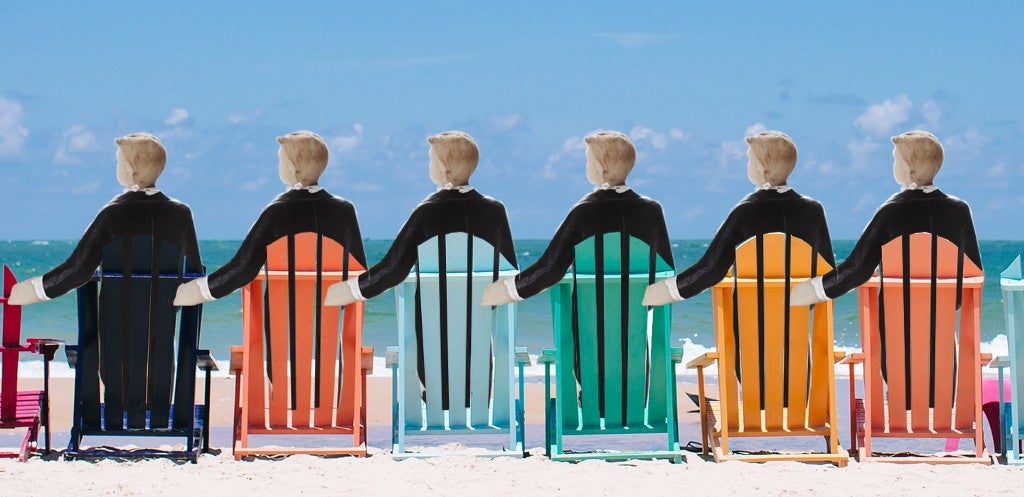The mission of the online registry Traveler’s Joy is to “help couples take their dream honeymoon.”
But more and more, that dream includes far more people than just the bride and groom. Or what is now being referred to as a “buddymoon”: a quick jaunt with members of the wedding party; an Airbnb with friends and extended family; or a couples’ retreat with the best man and maid of honor.
“We’ve definitely seen an increase in young people interested in group honeymoons,” says Brandon Warner, co-founder and CEO of Traveler’s Joy, who tells me that in 2016 nearly 10 percent of his clients opted for a buddymoon. Meanwhile, a recent report from Priceline found that 12 percent of the 1,000 Americans surveyed said they’d attended a group honeymoon in the last five years.
Maybe we’re imitating the celebs who’ve done the same: Jennifer Aniston and Justin Theroux famously buddymooned in 2015 at the Four Seasons Resort Bora Bora with Courteney Cox, Chelsea Handler, Jason Bateman and Jimmy Kimmel.
“We had thought about it,” Theroux told Extra at the time. “We could just do a normal honeymoon, or we could go with friends, keep the party going, relax and have fun.” Johnny Depp and Amber Heard were similarly inspired after their 2015 wedding on Depp’s island in the Bahamas, opting to cruise with a group of guests aboard Depp’s yacht for their buddymoon.
Yacht or not, one thing it isn’t: Your parents’ honeymoon at the Beautiful Mount Airy Lodge in the Poconos, complete with round beds and heart-shaped hot tubs.
Here are six things to know about the trending postnuptial millennial retreat:
1) It’s related to millennials’ extended adolescence.
As modern-day couples delay marriage into their 30s, the honeymoon’s value proposition has changed: Reconnecting with old friends during peak professional years is more appealing to some millennials than taking a traditional honeymoon, where the primary mission was to allow the bride and groom to bone (finally) in paradise (preferably). These days, couples are likely to have already been living and vacationing (and thus, boning) together for years.
2) It’s related to millennials not making as much money.
A report earlier this year in USA Today stated that millennials earn 20 percent less than baby boomers did at the same stage of life. According to a survey from the wedding website TheKnot.com, the average cost of a wedding in 2016 was $35,329, an all-time high. (That price nearly triples in Manhattan.) So it’s understandable that young couples are looking for ways to pinch pennies on their honeymoon.
A recent report from the foreign-exchange specialists Travelex showed that nearly half of millennials surveyed would consider buddymooning if it cut costs by 25 percent; another 40 percent could be convinced by a 50-percent savings. And that’s entirely possible: Buddymoons can take advantage of group discounts and share villas and costs throughout their holiday, often meaning they can afford to do more activities or upgrade their experience overall. “With young couples feeling the growing financial squeeze of tying the knot, it’s unsurprising that many are bucking traditional honeymoon trends in order to reign in the cost of getting married,” explained Elvin Eldić, Travelex’s global product director . “It makes perfect sense to continue the celebrations with loved ones, while sharing the costs.”
3) It’s related to millennials not taking time off.
Warner chalks the buddymoon trend up to fewer young people vacationing: When a wedding arises, they view it as a rare opportunity for everyone to travel together. (According to a new report from “Project: Time Off,” half of millennial employees surveyed think it will impress the boss if they never take time off.)
4) It’s related to millennials seeking adventure.
Young people are always on the lookout for the meaning of life. Or as a recent millennial study from Eventbrite — “Fueling the Experience Economy” — put it: “Living a meaningful, happy life is about creating, sharing and capturing memories earned through experiences that span the spectrum of life’s opportunities.”
To that end, the top five most popular destinations for U.K. buddymooners are: Dubai, Thailand, France, South Africa and Turkey. International Traveller, an online magazine that “connects modern explorers to incredible experiences” suggests buddymoons in Blanket Bay, New Zealand; Tuscany, Italy; and Addo National Park, South Africa. Warner of Traveler’s Joy tells me a couple rented four cabins for a week last summer in Alaska — the couple stayed in one cabin and friends and family stayed in the other three — making the most of outdoorsy activities, including fishing, boating and hiking.
5) It may not only be related to millennials.
My friend Christopher Reed went on a buddymoon in 1982. Anne and Dennis, his roommates of two years, were married in Santa Cruz, and he was the best man. They planned a low-key honeymoon to some of California’s lesser-known attractions they’d never visited, and at the last minute, they asked him to come along, too. “My reaction was, Uh, what? This is your honeymoon! To which they both shrugged and said, “So what?”
Reed thinks the early-1980s buddymoon worked because they were just three young friends who enjoyed each others’ company. He notes, however, that Anne and Dennis divorced six years later. “Maybe they should have taken it a bit more seriously?” he jokes.
6) It is, though, related to millennials not giving a shit about traditions.
Young people are likely forgoing traditional honeymoons for the same reason they don’t respect strict dress codes and rigid office hours in the workplace, or attend meetings to talk about meetings. If the only reason something is done a certain way is “that’s how it’s always been done” — like booking the Mount Airy Lodge Honeymoom Suite for 10 days — the buddymoon will win every time.

